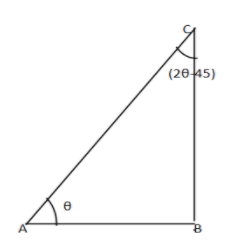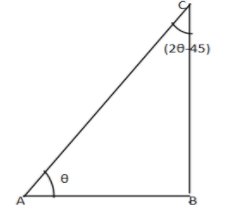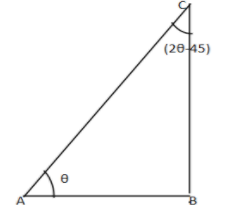
If $\theta {\text{ and (2}}\theta - 45)$ are the acute angles and $\sin \theta = \cos (2\theta - 45)$, then $\tan \theta $ is:


Answer
565.8k+ views
Hint:
We know that $\theta {\text{ and (2}}\theta - 45)$ are acute angles so we can say that $\theta < 90$ and also that ${\text{(2}}\theta - 45) < 90$ and also we know that $\sin \theta = \cos (2\theta - 45)$ and we know that $\cos ( - \theta ) = \cos (\theta )$
Complete step by step solution:
Here in the question we are given that $\theta {\text{ and (2}}\theta - 45)$ are the acute angles and it satisfies that$\sin \theta = \cos (2\theta - 45)$

Now we know that $\cos ( - \theta ) = \cos (\theta )$
So we can say that $\cos (2\theta - 45) = \cos (45 - 2\theta )$
Now adding and subtracting $45$ from both the sides we get that
$
\Rightarrow \cos (2\theta - 45 + 45 - 45) = \cos (45 - 2\theta + 45 - 45) \\
\Rightarrow \cos (2\theta - 45 + 45 - 45) = \cos (90 - 2\theta - 45) \\
$
Also we know that $\cos (2\theta - 45) = \sin (\theta )$
So we can write that
$\sin \theta = \sin (2\theta + 45)$
We know the formula that if $\sin \alpha = \sin \beta $ then its general equation can be formed by
$\alpha = n\pi + {( - 1)^n}\beta $
So here $\alpha = 2\theta + 45,\beta = \theta $
So we get that the general equation of the $\sin \theta = \sin (2\theta + 45)$ is
$2\theta + 45 = n\pi + {( - 1)^n}\theta $
So we can write $45^\circ $ as $\dfrac{\pi }{4}$ in radians then we will get that
$2\theta + \dfrac{\pi }{4} = n\pi + {( - 1)^n}\theta - - - - - - (1)$
Here in the question we are given that $\theta {\text{ and (2}}\theta - 45)$ are the acute angles so we know that
$\Rightarrow {\text{(2}}\theta - 45) < 90$
$
\Rightarrow {\text{2}}\theta < 90^\circ + 45^\circ \\
\Rightarrow {\text{2}}\theta < 135^\circ \\
\Rightarrow \theta < 67.5^\circ \\
$
Also we know that $0^\circ < \theta < 90^\circ $
So putting $n = 0$ in equation (1) we get that
$
\Rightarrow 2\theta + \dfrac{\pi }{4} = 0 + {( - 1)^0}\theta \\
\Rightarrow \theta = - \dfrac{\pi }{4} \\
$
So we get it is not the acute angle.
Put $n = 1$we get that
$
\Rightarrow 2\theta + \dfrac{\pi }{4} = \pi + {( - 1)^1}\theta \\
\Rightarrow \theta = \dfrac{\pi }{4} \\
$
So we get that it is the acute angle
Put $n = 2$ we get that
$
\Rightarrow 2\theta + \dfrac{\pi }{4} = 2\pi + {( - 1)^2}\theta \\
\Rightarrow \theta = \dfrac{{7\pi }}{4} \\
$
So this is also not an acute angle so we get that $\theta = \dfrac{\pi }{4}$
So we can find $\tan \theta = \tan \dfrac{\pi }{4} = 1$
Note:
We also know that sum of all the angles in the triangle is $180^\circ $

So we can say that
$
\Rightarrow \angle A + \angle B + \angle C = 180^\circ \\
\Rightarrow \theta + 2\theta - 45 + 90 = 180 \\
\Rightarrow \theta = 45^\circ \\
$
Therefore it will also satisfy that
$\Rightarrow \sin \theta = \cos (2\theta - 45)$
$
\Rightarrow \sin 45 = \cos 45 \\
\Rightarrow \dfrac{1}{{\sqrt 2 }} = \dfrac{1}{{\sqrt 2 }} \\
$
Hence we can do it like this also.
We know that $\theta {\text{ and (2}}\theta - 45)$ are acute angles so we can say that $\theta < 90$ and also that ${\text{(2}}\theta - 45) < 90$ and also we know that $\sin \theta = \cos (2\theta - 45)$ and we know that $\cos ( - \theta ) = \cos (\theta )$
Complete step by step solution:
Here in the question we are given that $\theta {\text{ and (2}}\theta - 45)$ are the acute angles and it satisfies that$\sin \theta = \cos (2\theta - 45)$

Now we know that $\cos ( - \theta ) = \cos (\theta )$
So we can say that $\cos (2\theta - 45) = \cos (45 - 2\theta )$
Now adding and subtracting $45$ from both the sides we get that
$
\Rightarrow \cos (2\theta - 45 + 45 - 45) = \cos (45 - 2\theta + 45 - 45) \\
\Rightarrow \cos (2\theta - 45 + 45 - 45) = \cos (90 - 2\theta - 45) \\
$
Also we know that $\cos (2\theta - 45) = \sin (\theta )$
So we can write that
$\sin \theta = \sin (2\theta + 45)$
We know the formula that if $\sin \alpha = \sin \beta $ then its general equation can be formed by
$\alpha = n\pi + {( - 1)^n}\beta $
So here $\alpha = 2\theta + 45,\beta = \theta $
So we get that the general equation of the $\sin \theta = \sin (2\theta + 45)$ is
$2\theta + 45 = n\pi + {( - 1)^n}\theta $
So we can write $45^\circ $ as $\dfrac{\pi }{4}$ in radians then we will get that
$2\theta + \dfrac{\pi }{4} = n\pi + {( - 1)^n}\theta - - - - - - (1)$
Here in the question we are given that $\theta {\text{ and (2}}\theta - 45)$ are the acute angles so we know that
$\Rightarrow {\text{(2}}\theta - 45) < 90$
$
\Rightarrow {\text{2}}\theta < 90^\circ + 45^\circ \\
\Rightarrow {\text{2}}\theta < 135^\circ \\
\Rightarrow \theta < 67.5^\circ \\
$
Also we know that $0^\circ < \theta < 90^\circ $
So putting $n = 0$ in equation (1) we get that
$
\Rightarrow 2\theta + \dfrac{\pi }{4} = 0 + {( - 1)^0}\theta \\
\Rightarrow \theta = - \dfrac{\pi }{4} \\
$
So we get it is not the acute angle.
Put $n = 1$we get that
$
\Rightarrow 2\theta + \dfrac{\pi }{4} = \pi + {( - 1)^1}\theta \\
\Rightarrow \theta = \dfrac{\pi }{4} \\
$
So we get that it is the acute angle
Put $n = 2$ we get that
$
\Rightarrow 2\theta + \dfrac{\pi }{4} = 2\pi + {( - 1)^2}\theta \\
\Rightarrow \theta = \dfrac{{7\pi }}{4} \\
$
So this is also not an acute angle so we get that $\theta = \dfrac{\pi }{4}$
So we can find $\tan \theta = \tan \dfrac{\pi }{4} = 1$
Note:
We also know that sum of all the angles in the triangle is $180^\circ $

So we can say that
$
\Rightarrow \angle A + \angle B + \angle C = 180^\circ \\
\Rightarrow \theta + 2\theta - 45 + 90 = 180 \\
\Rightarrow \theta = 45^\circ \\
$
Therefore it will also satisfy that
$\Rightarrow \sin \theta = \cos (2\theta - 45)$
$
\Rightarrow \sin 45 = \cos 45 \\
\Rightarrow \dfrac{1}{{\sqrt 2 }} = \dfrac{1}{{\sqrt 2 }} \\
$
Hence we can do it like this also.
Recently Updated Pages
Two men on either side of the cliff 90m height observe class 10 maths CBSE

What happens to glucose which enters nephron along class 10 biology CBSE

Cutting of the Chinese melon means A The business and class 10 social science CBSE

Write a dialogue with at least ten utterances between class 10 english CBSE

Show an aquatic food chain using the following organisms class 10 biology CBSE

A circle is inscribed in an equilateral triangle and class 10 maths CBSE

Trending doubts
Why is there a time difference of about 5 hours between class 10 social science CBSE

Write a letter to the principal requesting him to grant class 10 english CBSE

What is the median of the first 10 natural numbers class 10 maths CBSE

The Equation xxx + 2 is Satisfied when x is Equal to Class 10 Maths

Which of the following does not have a fundamental class 10 physics CBSE

State and prove converse of BPT Basic Proportionality class 10 maths CBSE




